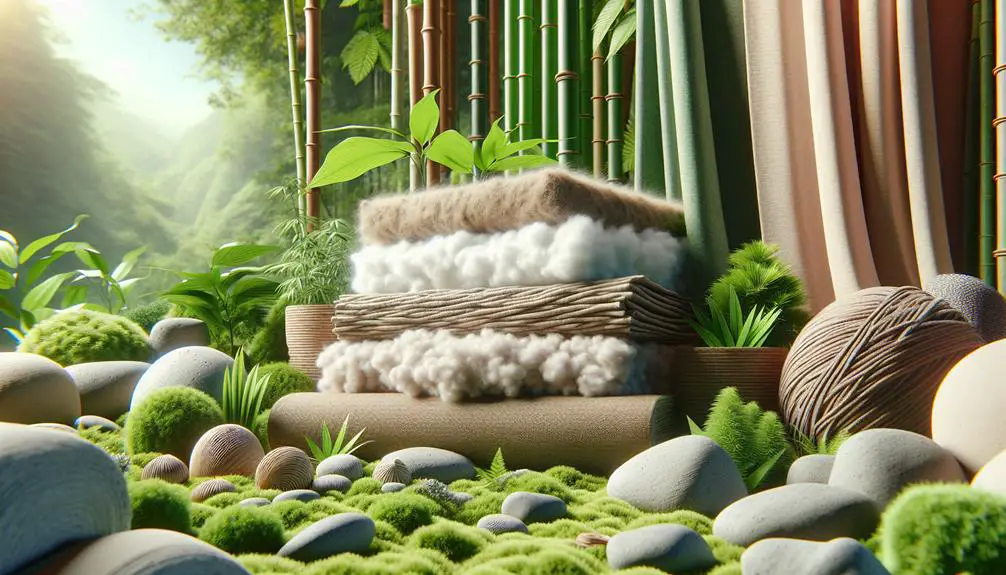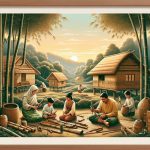You're likely aware that the textile industry is seeing a shift towards sustainability, but have you considered how biodegradable and compostable fabrics play a role? These innovative materials, ranging from hemp to bamboo, are not only eco-friendly but also versatile across various sectors. Imagine wearing clothing that decomposes naturally or using disposable medical textiles that leave no environmental footprint. Sounds promising, doesn't it? Yet, the journey from production to practical application isn't without its challenges. So, what exactly makes these fabrics stand out, and where do they fit into our daily lives?
Table of Contents
Key Takeaways
- Biodegradable fabrics like hemp and bamboo minimize environmental impact through sustainable sourcing and eco-friendly manufacturing.
- Innovations include bio-based fibers, eco-friendly dyes, and advanced recycling techniques for sustainable textile production.
- Fashion brands and home textile industries are increasingly adopting biodegradable fabrics for sustainable product lines.
- Compostable fabrics improve soil health and reduce landfill waste when decomposed under proper conditions.
- Technological advancements enhance the durability and cost-effectiveness of biodegradable fabrics, expanding their real-world applications.
Understanding Biodegradability
To comprehend biodegradability, you need to know how materials break down naturally into non-toxic components. This process involves microorganisms like bacteria and fungi that decompose organic matter, transforming it into water, carbon dioxide, and biomass. For a material to be truly biodegradable, it should break down completely and harmlessly within a reasonable timeframe.
Biodegradability research plays a pivotal role in identifying how different materials interact with the environment. Scientists study various polymers, natural fibers, and additives to determine their breakdown rates and final by-products. This research is essential for developing materials that minimize pollution and landfill waste. You'll find that understanding these studies can provide insights into which products are genuinely eco-friendly and which simply claim to be.
Environmental impact analysis is another vital aspect. It assesses the broader consequences of a material's lifecycle—from production to decomposition. By examining factors like resource consumption, energy use, and emissions, you can make informed choices about which materials to support.
This analysis helps guarantee that biodegradable materials don't just break down faster, but also have a reduced overall environmental footprint. Armed with this knowledge, you're better equipped to contribute to sustainable practices.
What Makes Fabrics Compostable
Compostable fabrics stand out because they break down fully into non-toxic, natural elements under specific composting conditions. To qualify as compostable, a fabric must meet strict compostability criteria. These standards guarantee the fabric will decompose within a set timeframe, leaving no harmful residues. The breakdown process involves microbial action, heat, and moisture, transforming the fabric into carbon dioxide, water, and organic matter.
Here's a simplified view of the compostability criteria:
| Criteria | Description | Importance |
|---|---|---|
| Biodegradability | Ability to be broken down by microorganisms | Ensures complete breakdown |
| Disintegration | Breaking into small pieces during composting | Facilitates microbial activity |
| Toxicity | Absence of harmful residues in the resulting compost | Safe for soil and plant well-being |
| Timeframe | Specific period within which breakdown occurs | Predictable composting process |
To master the breakdown process, you should understand that composting involves more than just throwing materials into a pile. Precise conditions, like proper temperature, humidity, and aeration, are essential. Microorganisms play a crucial role in the degradation, converting the fabric into valuable compost. By adhering to these compostability criteria, compostable fabrics contribute significantly to sustainable practices, ensuring no harmful impact on the environment.
Types of Biodegradable Fabrics
When you're looking for eco-friendly options, several types of biodegradable fabrics can help reduce environmental impact. Hemp textiles are a prime choice, known for their durability and minimal need for pesticides. They naturally resist mold and ultraviolet light, making them versatile for various applications.
Similarly, bamboo textiles offer impressive sustainability. Bamboo grows rapidly and requires little water or chemicals, and its fibers can be transformed into soft, breathable fabrics that are perfect for clothing and home goods.
Soy textiles are another innovative option. Derived from tofu production waste, soy fibers produce a fabric often referred to as 'vegetable cashmere' due to its silky texture. It's not only biodegradable but also highly renewable, making it an excellent choice for sustainable fashion enthusiasts.
Corn textiles, made from polylactic acid (PLA) derived from corn starch, are an exciting development in the world of biodegradable fabrics. They offer durability and flexibility, ideal for both clothing and industrial applications.
Production Processes
When considering the production processes of biodegradable and compostable fabrics, you'll want to focus on:
- Sustainable material sourcing
- Eco-friendly manufacturing techniques
- Waste reduction strategies
These elements guarantee that the entire lifecycle of the fabric minimizes environmental impact.
Let's explore how these practices contribute to more sustainable textile production.
Sustainable Material Sourcing
Sourcing sustainable materials for biodegradable and compostable fabrics involves selecting natural fibers like organic cotton, hemp, and bamboo, which have minimal environmental impact during their production processes. You need to prioritize sustainable sourcing to guarantee that these fibers are cultivated without harmful pesticides and synthetic fertilizers. By doing so, you support the health of ecosystems and soil quality.
Ethical practices are equally vital. When you source materials, aim to work with suppliers who ensure fair wages and humane working conditions. This not only fosters a positive social impact but also enhances the overall sustainability of the fabric production process. Remember, the goal is to create a supply chain that respects both the environment and the people involved.
Additionally, consider the water usage of your chosen fibers. For instance, organic cotton requires notably less water than conventional cotton, making it a more sustainable option. Hemp and bamboo are also advantageous due to their rapid growth rates and low resource requirements. By making informed choices, you can greatly reduce the ecological footprint of your biodegradable and compostable fabrics, aligning them with your commitment to sustainability and ethical practices.
Eco-Friendly Manufacturing Techniques
Incorporating eco-friendly manufacturing methods ensures that the production processes for biodegradable and compostable fabrics minimize environmental impact. By leveraging sustainable practices, you guarantee that every step, from raw material selection to final product, aligns with ecological principles.
One vital aspect involves utilizing green technologies that reduce energy consumption and emissions. For example, adopting closed-loop systems recycles water and chemicals, notably cutting down on waste.
You can also prioritize the use of renewable energy sources like solar and wind to power manufacturing facilities. This not only reduces the carbon footprint but also sets a precedent for responsible industrial behavior.
Advanced dyeing methods, such as waterless dyeing, conserve vast amounts of water and prevent harmful chemicals from contaminating natural water bodies.
Additionally, integrating automation and precision machinery minimizes material waste and enhances production efficiency. By focusing on these innovative practices, you not only contribute to a healthier planet but also produce high-quality, eco-friendly fabrics.
It's essential to stay updated on the latest advancements in green technologies, as they continually evolve, providing new opportunities to enhance sustainability. Embrace these techniques to lead the way in eco-conscious manufacturing.
Waste Reduction Strategies
To minimize waste in production processes, you should implement strategies like efficient material usage and recycling initiatives. By focusing on a circular economy, you can reduce waste to a great extent. Start by optimizing patterns to maximize fabric use, thereby minimizing off-cuts. Utilize software that calculates the most efficient layouts for cutting materials. This not only conserves resources but also cuts costs.
Incorporate recycling initiatives within your production line. Collect and repurpose fabric scraps and off-cuts to create new products or reintegrate them into the manufacturing process. This approach not only aligns with sustainable fashion but also promotes ethical consumption by reducing the environmental impact of your operations.
Additionally, consider the adoption of biodegradable and compostable fabrics. These materials, when used effectively, ensure that even end-of-life products contribute positively to the environment. Develop partnerships with suppliers who prioritize sustainable practices, thereby reinforcing your commitment to a circular economy.
Environmental Benefits
Biodegradable and compostable fabrics greatly reduce waste and pollution, contributing to a healthier environment. By integrating these materials into your wardrobe, you're actively reducing your carbon footprint. They break down naturally without releasing harmful chemicals, making them a cornerstone of sustainable practices. You're not just wearing clothing; you're wearing a commitment to the planet's future.
Consider the following environmental benefits:
| Benefit | Description | Impact |
|---|---|---|
| Waste Reduction | Decomposes naturally, reducing landfill use | Less environmental strain |
| Lower Carbon Footprint | Reduced emissions during production and degradation | Healthier atmosphere |
| Soil Health Improvement | Enriches soil when composted | Enhanced agricultural productivity |
| Water Conservation | Requires less water to produce | Preservation of water resources |
| Non-Toxic Breakdown | No harmful chemicals released upon decomposition | Safer ecosystems |
These fabrics also support soil health by contributing nutrients when composted. They require less water in their lifecycle compared to conventional textiles, aiding water conservation efforts. Additionally, their non-toxic breakdown means you're preserving ecosystems and biodiversity. By choosing biodegradable and compostable fabrics, you're not just making a fashion statement—you're making a positive environmental impact.
Challenges and Limitations
When considering biodegradable and compostable fabrics, you must address their limited durability, which can restrict their use in certain applications. Additionally, production costs for these fabrics are often higher than those for traditional materials, posing a significant barrier.
Understanding these challenges is essential for making informed decisions about their adoption.
Limited Durability Concerns
Despite their eco-friendly appeal, biodegradable and compostable fabrics often face criticism for their limited durability. When you opt for these fabrics, you might find them less resilient than their synthetic counterparts. Durability issues can lead to an increased frequency of replacement, which might counteract some of the positive environmental impacts you were aiming for.
Understanding the durability concerns is essential for making informed decisions:
- Wear and Tear: These fabrics can wear out faster, especially if used in high-friction environments.
- Moisture Sensitivity: They might degrade quicker when exposed to moisture, limiting their application in wet conditions.
- UV Exposure: Prolonged exposure to sunlight can weaken the fibers, reducing lifespan.
- Strength: Generally, they lack the tensile strength found in synthetic materials, which can be a drawback for certain applications.
- Maintenance: They often require more delicate care, increasing the risk of damage during cleaning.
Production Cost Barriers
Producing biodegradable and compostable fabrics often involves higher expenses due to specialized materials and manufacturing processes. You face challenges in balancing economic feasibility with the desire for sustainable practices. These fabrics require innovative raw materials and advanced technologies, which can greatly increase production costs.
Consider the table below for a clearer comparison:
| Aspect | Biodegradable Fabrics | Conventional Fabrics |
|---|---|---|
| Material Costs | High | Low |
| Manufacturing | Specialized | Standard |
| Market Demand | Growing | Established |
| Technological Needs | Cutting-edge | Traditional |
In order to make biodegradable fabrics more feasible, you need to focus on technological advancements that can lower production expenses. This could involve optimizing manufacturing processes or discovering more cost-efficient materials. Additionally, the market demand for sustainable options is increasing, which can drive economies of scale and reduce expenses over time.
While you aim for sustainability, it's essential to make sure that these fabrics can compete economically with conventional options. By addressing these production cost barriers, you'll make biodegradable and compostable fabrics more accessible and appealing to a broader market, ultimately supporting a shift towards sustainable practices.
Innovations in Textile Industry
You'll be amazed by the groundbreaking innovations in the textile industry that are making biodegradable and compostable fabrics a reality. As you explore this exciting field, you'll find that sustainable textiles aren't just a trend but a revolutionary shift in design and production. These advancements are paving the way for circular fashion, where materials are reused, recycled, and ultimately returned to the earth without harm.
Here are some key innovations driving this transformation:
- Bio-based Fibers: New plant-based fibers, like those derived from hemp and bamboo, are being developed to replace traditional, non-biodegradable materials.
- Eco-friendly Dyes: Innovations in natural dyes are reducing the environmental impact of textile coloring, eliminating harmful chemicals from the process.
- Advanced Recycling Techniques: Cutting-edge recycling methods are enabling the breakdown and reuse of synthetic fibers in a more sustainable manner.
- Smart Manufacturing Processes: Automation and AI are streamlining production, reducing waste, and improving overall efficiency in creating biodegradable fabrics.
- Enhanced Compostability: Researchers are engineering fabrics that not only decompose quickly but also enrich the soil when they do.
These innovations aren't just about reducing waste; they're reshaping how we think about fashion and sustainability.
Real-World Applications
Now let's see how these groundbreaking innovations are being applied in the real world, transforming everyday fashion and textiles into eco-friendly solutions.
In the fashion industry, biodegradable and compostable fabrics are gaining traction. Brands are creating chic, sustainable clothing lines that appeal to environmentally conscious consumers. You'll find these fabrics in everything from couture gowns to casual wear, making it easier than ever to dress sustainably.
In home textiles, these materials are revolutionizing products like bed linens, curtains, and upholstery. Imagine sleeping on sheets that can return to the earth without leaving a trace. Such innovations not only reduce waste but also offer you peace of mind knowing your choices contribute to a healthier planet.
Beyond consumer goods, industrial applications and commercial uses of biodegradable fabrics are also expanding. Hospitals and other healthcare facilities are adopting compostable textiles for disposable gowns and linens, minimizing medical waste. Even in agriculture, these fabrics are used for mulch films and plant wraps, which decompose naturally and enrich the soil.
Future Prospects
The future of biodegradable and compostable fabrics looks extremely promising, with advancements likely to drive even more sustainable innovations in the textile industry. You're witnessing a surge in market demand for eco-friendly products, prompting companies to invest in cutting-edge technological advancements. This momentum won't only enhance fabric quality but also reduce environmental impact.
To stay ahead, focus on these emerging trends:
- Market demand: As consumers increasingly prioritize sustainability, the market for biodegradable and compostable fabrics will expand, encouraging more brands to adopt these materials.
- Technological advancements: Innovations in material science will lead to more durable, versatile, and cost-effective biodegradable fabrics, making them competitive with traditional textiles.
- Regulatory compliance: Governments are implementing stricter environmental regulations, pushing manufacturers to comply with eco-friendly standards, thereby fostering widespread adoption.
- Consumer education: Educating consumers about the benefits and proper disposal of biodegradable fabrics will be essential. Informed consumers are more likely to support sustainable products.
- Circular economy: Developing a closed-loop system where fabrics are designed for easy recycling and composting will further minimize waste and maximize resource efficiency.
Frequently Asked Questions
How Can Consumers Identify Biodegradable Fabrics in the Market?
You can identify biodegradable fabrics by looking for eco-friendly labeling and certifications. Stay updated on sustainable fashion trends, which often highlight brands committed to environmentally responsible practices. Always check tags and product descriptions carefully.
Are Biodegradable Fabrics More Expensive Than Traditional Fabrics?
Yes, biodegradable fabrics are generally more expensive than traditional fabrics. However, when you consider the cost comparison, their environmental benefits can justify the higher price, making them a valuable investment for sustainable living.
Can Biodegradable Fabrics Be Dyed or Printed On?
Yes, you can dye and print on biodegradable fabrics. Advanced dyeing techniques and eco-friendly printing methods are available, ensuring vibrant colors and intricate designs without compromising the fabric's biodegradability or environmental benefits.
What Are the Care Instructions for Biodegradable Fabrics?
Think of biodegradable fabrics as delicate flowers. Follow gentle washing instructions: cold water, mild detergent, and air drying. For storage recommendations, keep them in a cool, dry place away from direct sunlight to preserve their integrity.
How Does the Lifespan of Biodegradable Fabrics Compare to Traditional Ones?
Biodegradable fabrics generally have a shorter lifespan compared to traditional ones. However, their environmental impact is much lower. You might find their durability sufficient for many uses, making them a smart, eco-friendly choice.
- Stylish Ways to Wear an Oversized Corduroy Jacket Today - July 4, 2025
- Repairing a Rip in Corduroy: Simple Steps to Restore Your Fabric - July 4, 2025
- The Color Palette of Corduroy: Exploring Its Shades and Styles - July 4, 2025





